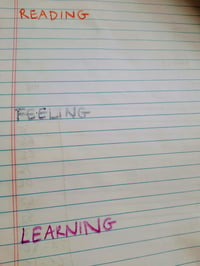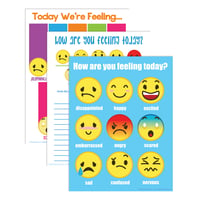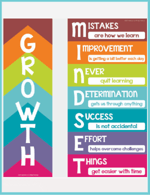By: VariQuest Visual and Kinesthetic Learning Suite on November 16th, 2022
Creating a Student Journal: What are you reading, feeling, and learning?
Lessons/Activities/Templates | Featured Topics: Lessons and Activities
 Journaling is widely regarded as one way to improve mental health, as writing and reading about our feelings and events help us to process the emotions behind them. And because the activity is valuable for any age capable of reading and writing, it's a simple activity we can all share.
Journaling is widely regarded as one way to improve mental health, as writing and reading about our feelings and events help us to process the emotions behind them. And because the activity is valuable for any age capable of reading and writing, it's a simple activity we can all share.
Because generating the ideas or what to write about tends to be the hard part, consider following this journaling idea: have each student complete one page per day, divided into three sections about what they're reading, feeling, and learning. If you'd like to "theme" your prompts, you have the option to make them as complex or as simple as you'd like. Have students submit entries they're particularly proud of, for sharing with the greater class, and use all students' reading, feeling, and learning entries as opportunities to foster larger lessons and discussions with the whole group. It's crowdsourcing, weaved into your curriculum!
What are you reading?
 Require students to read at least one book (or chapter), online article (from a trusted source), or newspaper story per day of journaling. This can be a book from home, an article recommended by you, or a newspaper lying around. Ask them to write about what they read, and how it translates to their own life and past experiences.
Require students to read at least one book (or chapter), online article (from a trusted source), or newspaper story per day of journaling. This can be a book from home, an article recommended by you, or a newspaper lying around. Ask them to write about what they read, and how it translates to their own life and past experiences.
Interested in more content on getting students to read? Check out our blog post titled, The Break Up With Reading: Why Reading for Fun is Important for Students.
How are you feeling?
 With so much going on in the world, this one is important. Students need outlets to share their feelings, especially those who may have less parental guidance or support at home. Writing about these feelings can often help students share in a safe way, and gives you, as their teacher, a mental check-in with them, to keep your emotional connection as a role model in their lives, and improve their academic performance when they feel supported and confident.
With so much going on in the world, this one is important. Students need outlets to share their feelings, especially those who may have less parental guidance or support at home. Writing about these feelings can often help students share in a safe way, and gives you, as their teacher, a mental check-in with them, to keep your emotional connection as a role model in their lives, and improve their academic performance when they feel supported and confident.
This may prompt another activity needed to explore emotions - consider this "How are you Feeling" activity complete with printables and posters!
What are you learning?
 As humans, we learn more than just one new thing every day - but some of those things stick with us more than others. For example, maybe your student learned a new fact about transmission of diseases, and how certain surfaces can harbor germs longer than others. Or maybe they learned a new song about the muffin man! Ask them to write about what they learned, and why that is important. Learning a new song (no matter how silly!) could be important to them because it involves memorizing words and melodies to keep their brains sharp and minds happy, while learning new facts about viruses taught them more about what they can do to stop their spread.
As humans, we learn more than just one new thing every day - but some of those things stick with us more than others. For example, maybe your student learned a new fact about transmission of diseases, and how certain surfaces can harbor germs longer than others. Or maybe they learned a new song about the muffin man! Ask them to write about what they learned, and why that is important. Learning a new song (no matter how silly!) could be important to them because it involves memorizing words and melodies to keep their brains sharp and minds happy, while learning new facts about viruses taught them more about what they can do to stop their spread.
Having a growth mindset helps us learn better - by believing in the power of "yet". Download this Growth Mindset banner for placing in your classroom to remind students that we can learn to do anything we put our minds to!
Encourage creativity in these journals with markers, magazine cutouts, stickers, or whatever makes writing feel personal to them. In a world where all ages are constantly learning, use what your students feel and share to guide your curriculum and lessons for the days to come. Are a lot of students feeling nervous? Teach them a social-emotional lesson about courage. Are the students struggling with writing? Consider a writer's workshop lesson plan. We all learn better when we do it together!
Interested in learning more about the VariQuest® Visual and Kinesthetic Learning Suite and how our Engage Every Learner Content can support you and your fellow educators in classrooms, school buildings, and greater learning communities? Request a no-obligation demonstration with one of our expert education consultants right now!


